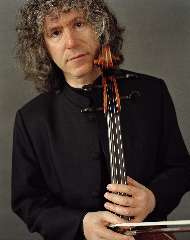|
Back
Passion in perfection, almost Zurich
Tonhalle
10/05/2010 -
Joseph Haydn: Symphony No. 99
Claude Debussy: Suite for Cello and Orchestra (reconstructed by Sally Beamish)
Camille Saint-Saëns: Cello Concerto No. 1, op. 33
Wolfgang Amadeus Mozart: Symphony No. 31 K.297 “Paris”
Steven Isserlis (Cello)
Zurich Chamber Orchestra, Muhai Tang (conductor)

S. Isserlis
Those who gathered early in the Tonhalle’s main foyer were treated unexpectedly to an entertaining and illuminating introduction to all the evening’s works by a lady in 18th century costume. I would still prefer a more comprehensive programme; the introduction was too “dumbed down” for my liking.
The Zurich Chamber Orchestra opened this concert with a scintillating performance of Mozart’s Symphony No. 31, the “Paris”. The opening movement Allegro assai, with its delightful themes, fizzed along with sterling work from all the violins (even though Mozart had twice the number of violins at his disposal when the work was premiered). Tang danced, as though on air, through the elegant Andante. The final Allegro with its surprise opening, a crashing entry of the full orchestra, then scampered merrily with yet more fine precision playing from the string sections before the brilliant coda brought the symphony to its jubilant close.
Then came the real interest of the evening. Every musicologist hopes to stumble across the forgotten or unknown manuscript of a famous composer in some dusty attic (one thinks of Vivaldi’s Four Seasons, Haydn’s Cello Concerto or much of Schubert’s music.) In the case of Debussy’s Suite for Cello, written in 1882, cellist Steven Isserlis combined forces with Scottish composer Sally Beamish to reconstruct a suite with five separate short movements from fragments left by Debussy. Beamish has faithfully orchestrated the two movements left by Debussy, the Prelude which was originally called the Intermezzo and the Scherzo. Beamish added three Debussy pieces to make up the Suite, two pieces for piano and one song. In these new works she allowed more liberties in order to ensure that the solo cello could stand out. The piece is varied and thoroughly entertaining, not a lost masterpiece though. It has been beautifully orchestrated, with tambourine, xylophone and harp adding almost magical Oriental colours.
After the interval, Isserlis was back to play Saint-Saëns Cello Concerto. Isserlis is known for the soft singing tone of his cello, enhanced no doubt by his penchant for use of gut strings. Where technical dexterity was demanded, such as the double stops or rippling triplet runs, Isserlis duly delivered. Intonation was never lost even in the most scurrying passages. Tang held back the orchestra to allow his soloist full reign. It was undoubtedly a brilliant tour de force, and yet one could not help recalling Saint-Saëns’ many critics, who thought his music shallow. The First Cello Concerto, whilst demanding the most of the cellist’s technical ability, has no memorable melodies and leaves one feeling strangely unfulfilled.
Tang then travelled metaphorically from Paris to London to tackle Haydn’s Symphony No. 99 , one of the "London", with its mellow tone colours, plangent expressiveness and contrapuntal detail. Tang stressed the surprisingly many dissonances and was strongest in the last two movements, visibly enjoying the jollity of the Menuet and the energetic Rondo which blazed, with relentless pulse, to the work’s powerful close.
Not entirely “Passion in perfection”, to use the ZKO’s theme for the whole season, but close enough.
John Rhodes
|